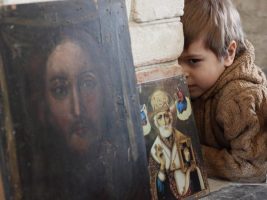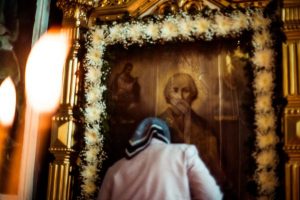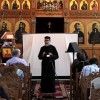
Fr. John Nankivell
As the Church of England prepares for a new Archbishop of Canterbury, Fr John Nankivell looks at the life and lasting influence of an earlier Archbishop of that see, St Theodore of Tarsus, focusing on the many ways in which this holy, wise and learned man transformed the Church in England.
664 AD was a year of dramatic events in Britain: ‘an eclipse was quickly followed by plague’ and the archbishop of Canterbury died. [1] In fact, there were very few bishops left, though two of the ablest to have served in these islands, the Irish-trained Angles Chad and Wilfrid, were on the point of being consecrated. And this was the year in which important decisions had been made at a meeting in Whitby.
At this critical time, the kings Egbert of Kent and Oswy of Northumbria conferred and selected a Kentish priest, Wighard, and sent him to Rome to be consecrated as successor to the recently deceased archbishop Deusdedit. Wighard reached Rome but died soon after his arrival. In a long letter, Pope Vitalian assured king Oswy that he was giving careful consideration to the choosing of a suitable successor and exhorted the king to continue to lead his people in the Catholic and Apostolic faith. The bearers of the letter were given relics of the Apostles and martyrs, the most valuable gifts that one church can bestow on another. Among them were relics of the holy martyr Pancratius, now known to most people through the London train terminus built in the vicinity of his church. [2]
The outcome of Pope Vitalian’s deliberations was the extraordinary appointment of Theodore, a sixty-six year old native of Tarsus, an un-ordained eastern monk. After ordination to the sub-diaconate, four months was needed for his hair to grow so that he could receive the circular tonsure, and he was consecrated bishop on 26 March 668.
There had been easterners in Italy for some decades, following the Persian and Arab invasions earlier in the century, and leaders of the church had arisen from their number, including Greek and Syrian popes. But why send an aged Syrian to Britain, which had no such eastern communities?
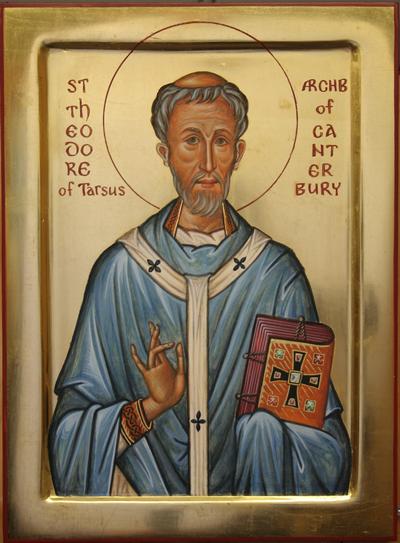
Four centuries under Rome had left the indigenous British with an educated leadership, a widely established church and settled Roman soldiers of various ethnicities. The names of some of the old Celtic kingdoms, such as Kent, Deira and Bernicia, survived into the Angle and Saxon kingdoms of the Germanic invaders of the fifth and sixth centuries. British kingdoms, such as Strathclyde, remained in the North, and the Irish kingdom of Dalriata, which was to be so important in the conversion of the pagan Germans, was established in the south west of what is now Scotland. The most important British kingdoms were in Cornwall and ‘Wales’, a ‘place for foreigners’ as the immigrant Anglo-Saxons called it. The northern Picts had their own kingdom, but some of those in the south were in the great English kingdom of Northumbria.
The ecclesiastical situation was also complex. The diocesan organisation of the fourth century, which followed the pattern established throughout the Christian Roman empire, was disrupted by the pagan Germanic kingdoms. Augustine of Canterbury’s disastrous failure to work with the indigenous church meant that the ‘Roman mission’ to the Anglo-Saxons took place without reference to existing British practice. The work of the Irish monks, which was initiated by the Northumbrian king Oswald, also took place largely within the Anglo-Saxon political structures. British Christians, pace Bede, played an unsung part in the conversion of the Anglo-Saxons, but warfare and massacre had left a heritage of ill-will.
A political patchwork, polyglot Britain was ethnically and ecclesiastically complicated. It seems extraordinary that anyone should think that an old Syrian monk, who spoke Latin as a third language and had no Anglo-Saxon or Irish, could begin to act as unifier and leader of such people. The choice was inspired: by the end of his twenty one years as archbishop, Theodore had raised the educational level of the church, enriched its liturgical and disciplinary life, established a diocesan structure consonant with the physical and cultural geography of the land, and had drawn the Church together through regular national synods.
Bede & modern assessment of Theodore
In 1966 I was in Patmos for Easter and had the opportunity to converse with the Elder Amphilochios Makris: ‘In Britain, you have the great saint Theodore’ he said. My theology degree from Oxford had not informed me about this ‘great saint’, so when next I could, I read what Bede had to say about him. A man of learning ‘both in sacred and secular literature’, he and his companion Hadrian ‘attracted a large number of students, into whose minds they poured the waters of wholesome knowledge day by day’. The heart of this knowledge was the holy Scripture, but it included poetry, astronomy and languages; the students became ‘as proficient in Latin and Greek as in their native tongue’. Bede describes an archbishop of enormous energy, travelling the length and breadth of Britain, consecrating new bishops, presiding over synods, establishing new dioceses, negotiating with kings, ensuring discipline and order, beautifying liturgical life, and always, and everywhere developing the level of learning. ‘Never had there been such happy times as these since the English settled in Britain.’ [3]
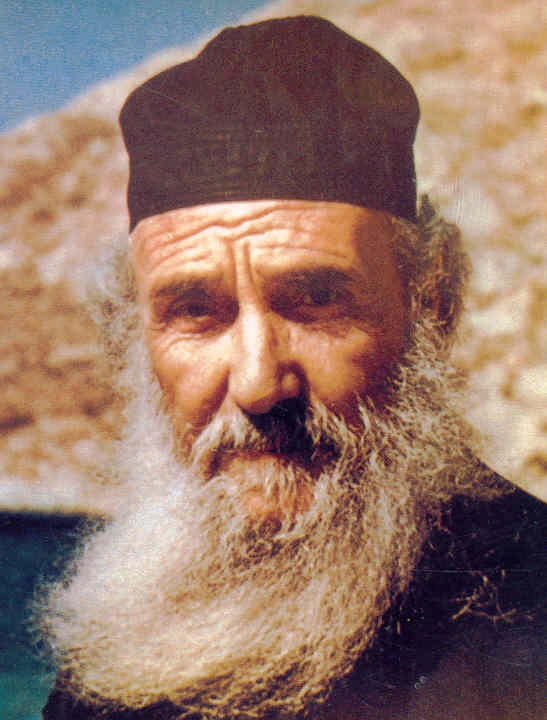
Elder Amphilochios of Patmos
Until 20 years ago, commentators felt unable to comment on Bede’s glowing assessment. In his posthumously published ‘Historical Commentary’ on Bede, Wallace Hadrill can say “we know nothing of Theodore’s books or library”. [4] But the work of Bischoff, Lapidge & Stevenson, published in the 1990s, has caused a dramatic change, and confirms Bede’s glowing assessment.
In 1936 the late Bernhard Bischoff visited the Biblioteca Ambrosiana in Milan in search of manuscript materials in that library pertaining to Virgilius Maro Grammaticus. The research led him to an eleventh century compendium of biblical materials in that library bearing the shelfmark M.79 sup. Among the contents of this manuscript, lying adjacent to the excerpts of Virgilius which had first attracted his attention, were several series of unprinted Latin biblical commentaries, and he noted that they contained references to Theodore and Hadrian, and included glosses in Greek and Old English, as well as quotations from a wide range of unusual Greek patristic authors Bischoff immediately recognised the extraordinary importance of these biblical commentaries. [5]
The war meant that the scholarly world heard of this momentous discovery only in 1953, and it was is was not until the 1980’s that Bischoff, in collaboration with Lapidge, who was working on the ‘Leiden Family’ glossaries, began the work of preparing an edition of the commentaries. They were published in 1994, together with an English translation and an accompanying commentary. This, together with the publication of the Laterculus Malialanus by Jane Stevenson in 1995, give us an insight into the life and work of Archbishop Theodore that has not been possible for a thousand years.
This talk will attempt to justify its title by reflecting on four facets of the gem that is St Theodore, God’s gift to Canterbury and Christendom.
The learned and gifted teacher
That Theodore and Hadrian were loved and influential teachers is clear from Bede; that their learning should continue to be influential for many years is apparent in the survival and transmission of lecture notes, so that we too can become their students.
Among their renowned students were the bishops Oftfor, Tobias and Aldhelm, and the abbot Albinus. Oftfor was one of the five bishops taught by St Hilda at Whitby. Wishing ‘to obtain greater perfection’, he went to Kent to continue his studies with Theodore, and carried out his main work of ‘preaching the faith and setting an example of holy life’ among the Hwiccas, the English tribe that had settled along the lower reaches of the Severn, whose bishop he became. [6] Tobias was ‘a man of wide learning and a scholar of Latin, Greek and Saxon’, who became bishop of Rochester. [7] The learning of Aldhelm, abbot of Malmesbury and later bishop of Sherborne, is well known through the survival of many of his writings. [8]
Albinus, who succeeded Hadrian as abbot of Canterbury, ‘was so well grounded in the study of the Scriptures that he had no small grasp of Greek, while he understood Latin as thoroughly as his native English tongue’. [9]
From the published commentaries, it is clear that Theodore and Hadrian were accomplished in the exegesis of Scripture. This is characterised by careful attention to the historical, topographical, scientific and linguistic background of the texts. There is, for example, an exposition of the various types of leprosy when this is mentioned in Mt 8.3, and of the various fevers at Mt 8.15; in each case the Latin and Greek terms are given and explained. The animals of Leviticus 11 are sometimes given their Greek and even Anglo-Saxon names: so ‘locusta’ is translated as ‘greshoppae’, ‘opupum’ [hoopoe] as ‘hupupa’, and ‘larum’ as ‘hragra’. In the case of hragra, the illuminating comment is made ‘Adrianus dicit meum esse’, one of the valuable indications of the origin of the commentaries. More detailed descriptions are sometimes provided, as with the cherogrillusof Lev 11.5, the coney of the Authorised Version, which is ‘similar in appearance to the pig, except that they are much smaller than pigs, but more elongated in size; and above all they abound in cracks in the rocks on Mount Sinai.’ [10] More significant objects are described in detail. About 300 words are devoted, for example, to the priestly garment, the Ephod. [11]
Such care to explain the literal meaning of the text is characteristic of ‘Antiochene’ exegesis, best known in the sermons of St John Chrysostom, to whom frequent reference is made in the Commentaries. But, as with others in this tradition, the deeper meanings of Scripture are discovered by means of typology.
Christ wished to be born in Bethlehem of Judaea the city of David, because of what was previously foretold to the fugitive Jacob. While he was asleep he saw a ladder reaching up to heaven, and perceived angels ascending and descending it, and saw God at the top. He said ‘This is truly the house of God, the gate of heaven,’ from which it is called Bethel [House of God]. The stone which Jacob put under his head is a similitude of the Corner-Stone, from which he made two walls meeting…and he joined them together, as it were the linking of the Jewish people with the gentiles, creating peace between both. [12]
Lapidge believes that when all the glossaries of the ‘Leiden-Family’ have been identified and studied, it is possible that the Canterbury school ‘will emerge from its present obscurity to be considered as one of the most influential sources of exegetical thought in the early Middle Ages.’ [13]
Theodore’s understanding of doctrinal issues, in particular of the monothelite heresy then plaguing Christendom, was unparalleled in the western world. Theodore was almost certainly involved in the Lateran Council of 649, along with Maximus the Confessor and Pope Martin, both of whom lost their lives as a consequence of their opposition to the imperial heresy. In 678 Emperor Constantine IV wrote to the Pope with a proposal to resolve the issue of monothelitism, an initiative that led to the convening of the 6th Ecumenical Council in 680. Pope Agatho [678-81] decided to consult all the western bishops before responding. In the case of Britain, he sent John, abbot of the monastery of St Martin and Arch-cantor of St Peter’s, ‘to make careful enquiries about the faith of the Church of the English’. [14] Abbot John brought with him a copy of the decisions made at the Lateran Council of 649, a transcript of which was made in the scriptorium of Benedict Biscop’s monastery in Monkwearmouth. The theological preamble to the British response to Pope Agatho, agreed at the council of Hatfield, closely follows that of the Lateran, in the drafting of which Theodore might well have played a part. As part of his apology for the delay in answering the Emperor, Pope Agatho explained that he had hoped that the learned ‘philosopher and archbishop of the great island of Britain’ Theodore might be able to attend the Council. The trust placed by the Pope in his ‘co-servant and fellow bishop’ to help in this complex theological issue is testament to the aged Theodore’s unique standing in the west at that time. [15]
Theodore’s legacy of order, organisation and discipline
The first thing that Theodore did on his arrival in Britain was ‘to visit every part of the island occupied by the English peoples’ and he ‘consecrated bishops in suitable places, and with their assistance he corrected abuses wherever he found them’ [16] The consecration of bishops to vacant dioceses was a clear priority, and Theodore set about this work immediately. But he was not hasty and was prepared to remove those he thought should not be in post. Chad, for example, was deposed from York because of his ‘irregular consecration’, [17] and Wynfrid of Mercia was deposed for some disobedience [18] The primary business of the first council to be held in Britain, which he called in Hertford in 672 or 673, was to ensure that all bishops understood and agreed to observe ‘all the canonical decrees of the ancient Fathers’. He produced a summary book of canons and marked ten chapters which he considered ‘to be of the greatest importance for us’. Six of the ten concern clerical discipline. For example, no bishop should intrude in the diocese of another, and clergy should serve only in their own diocese, and visit another only with letters of permission from both bishops. [19] Such canons were well-established by the time of the first council of Nicaea. The content of these canons is well known, but the exact source from which Theodore is quoting is not at all clear. The question of sources is discussed by Martin Brett in Theodore and the Latin Canon Law. [20]
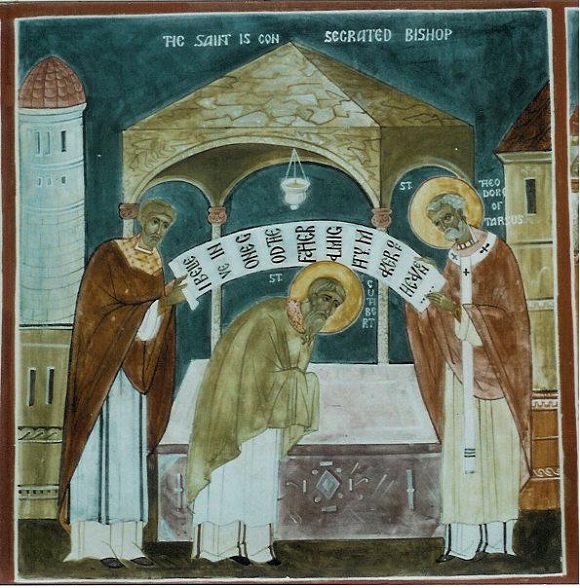
St. Theodore consecrating St. Cuthbert to the episcopacy
After four years of visiting, teaching, listening, establishing order and discipline, and, presumably, improving his Anglo-Saxon, he was in a position to indicate his longer-term strategy, which was to create a diocesan structure that better served the needs of the country. This he introduced with careful diplomacy by means of a discussion with the assembled bishops at Hertford ‘that more bishops shall be consecrated as the number of the faithful increases’. Increasing the number of dioceses would be challenging for the existing bishops, and the council said that ‘we have announced no decision in the matter for the present’. [21]
The Anglo-Saxon kingdoms followed natural boundaries, influenced by the pre-existing Roman provinces and the old Celtic kingdoms. The church dioceses were often coterminous with the kingdom and could be enormous. Theodore’s policy was to divide these enormous dioceses and to create new dioceses for the peoples on the borders of the main kingdoms, such as the Picts in the north and the Hwicce of the Severn valley. Having laid down a clear marker at Hertford, his strategy was to await political developments so that his potentially explosive policy could be implemented with the maximum chance of success, and then to act quickly and decisively. The opportunity to divide Northumbria arose in 678, when king Egfrid expelled bishop Wilfrid. Theodore immediately consecrated two bishops, one for Deira with his seat in York, and the other for Bernicia to be ruled from Hexham or Lindisfarne. The same year he created the new see of Lindsey, recently won by Egfrid from the Mercians, and in 681 he appointed a bishop for the southern Picts. [22]
The division of Northumbria was based on ancient borders, and this commitment to existing cultural and historical traditions is central to Theodore’s policy. It can be seen in the threefold division of Mercia and Kent, and in the creation of new dioceses for the Hwicce at Worcester and probably for the Magonsaetan at Hereford. [23] The seventh of the ten key chapters discussed and agreed at Hertford concerned the establishment of annual synods. [24] These councils were to be held at ‘Clofaeshoh’, the identity of which is unknown. Brixworth in Leicestershire, central to the whole country, its magnificent Saxon church and links with the early English missionary Boniface indicative of its importance, and its topology – an upturned cloven heel, or cloveshoe – is a strong contender. [25] In fact the only firmly attested councils to be held here date from the middle of the eighth century, [26] and the only further council of which Bede gives us information is that held at Hatfield in 680. The fundamental theological under-pinning of church life was firmly asserted at this council, which affirmed the commitment of all the bishops to the decisions of the five Ecumenical Councils: Nicaea 325, Constantinople 381, Ephesus 431, Chalcedon 451 and Constantinople 553. [27] In the main these annual councils will have been largely concerned with order and discipline.
The one part of Theodore’s legacy that bears his name is that of penitential discipline – the Penitential of Theodore and the Iudicia Theodori. The complex connections of the texts that carry his name to other penitential texts and books of canons, and the extent to which they owe their origin to Theodore are unpicked by Thomas Charles-Edwards. [28] What emerges from his study is that both men and women flocked to learn from this ‘man of knowledge unparalleled in our age’, and that his guidance was particularly influential in Ireland, but also on the continent. A comparison of the penitential practice in the British Isles before Theodore’s arrival with that advocated in his penintentials tells us something of the subtlety and understanding of our archbishop. For example the more rigorous rules on divorce practised on his arrival were tempered by those of St Basil. On the other hand the local practice of private penance for sins of all sorts overseen by the priest, which was the norm among the Britons and Irish, takes the place of public confession of major sins in the presence of the bishop, assumed in St Basil and the other Greek texts. The willingness of a man, steeped in a lifetime of a particular practice, to adjust a rich and authoritative tradition to a new situation, is another illustration of his pragmatic flexibility.
His diplomatic gifts and political realism
The apparent ease with which Theodore adopted a radically new life, at an age when most of us are content with our old habits and unwilling to change, shows his exceptional ability to listen and learn. His standing as Archbishop gave him access to all the kings, and his profound knowledge of the canons provided him with well-developed procedures based on six centuries of church life. He neither abused the former, nor was he hidebound by the latter. He was prepared to act swiftly when opportunity arose, and was prepared to apply ‘oikonomia’ when a rigid adherence to the canons would not be in the best interests of the church. Both these things are illustrated in the case of the division of the diocese of Northumbria. The final reconciliation with Wilfrid is a telling illustration of Theodore’s genuine humanity and love, and his adherence to the Gospel that holds humility as the first of the virtues. [29]
His gifts to the liturgical life of Britain
Theodore would not have introduced any modifications to the existing Roman rite practised in Britain. But there is good reason to believe that he and Hadrian brought with them the devotion to the saints who were particularly commemorated in their own monasteries. Bede’s Martyrologium and other early English martyrologies include saints from the Greek Menaia and from the Syriac calendars, that one would not expect to find in the West. The case for attributing their inclusion to Theodore is convincingly demonstrated by Christopher Hohler. [30] They also have Capuan saints who would surely have arrived here through Hadrian.
In one case we have a complete life of an early seventh century martyr. The Persian soldier Magundat was present at Ctesiphon when the true cross, taken by the army of Chosroes II in the sack of Jerusalem in 614, arrived there. Interested to discover more about the religion of the Cross, he travelled in the Christian world, was baptised Anastasius in Jerusalem, and became a monk. After seven years, and inspired by the lives of the early martyrs, he left to be among his own people. This culminated in his martyrdom by strangulation in Kirkuk. The Greek life of this saint, together with an icon and a relic, had reached the Cilician monastery ad Aqua Salvias in Rome by the middle of the seventh century. A version of this life with an inter-linear Latin version, which follows the Greek in a pedantic and literal manner, is extant, and there is reason to believe that it is the work of Theodore himself. [31]
God’s gift to Canterbury
So this vigorous old man had an immediate impact on his contemporaries and a lasting influence on the church and people of Britain. His ability to apply the learning and experience of an eastern monk to the spiritual, educational, administrative and liturgical needs of the English, Irish, British and Pictish peoples who made up his archdiocese is a vivid testimony to the gifts that Pope Vitalian discerned in 664.
Bibliography
Bede, A History of the English Church and People, tr. Leo Sherley-Price Penguin 1955
Bernhard Bischoff & Michael Lapidge (eds), Biblical Commentaries from the Canterbury School of Theodore and Hadrian, Cambridge Studies in Anglo-Saxon England 10, CUP 1994
John Blair, The Church in Anglo-Saxon Society, OUP 2005
R H C Davis, ‘Brixworth and Clofesho’, Journal of the British Archaeological Society 3rd ser. 25, 1962 p 71
Margaret Gelling, Place-Names in the Landscape,London 1984
Simon D Keynes, The Councils of Clofesho, Vaughan Paper No 38, University of Leicester. Eleventh Brixworth Lecture 1993
Michael Lapidge (ed), Archbishop Theodore,Cambridge Studies in Anglo-Saxon England 11, 1995
Lapidge M and Herren M.W., Aldhelm: the Prose Works, Cambridge 1979
Lapidge M and Rosier J.L., Aldhelm: the Poetic Works, Cambridge 1985
John Nankivell, St Wilfrid, SPCK 2002
Sir Frank Stenton, Anglo-Saxon England, OUP, 3rd Edition 1971
Jane B Stevenson, The ‘Laterculus Malialanus’ and the School of Archbishop Theodore, Cambridge Studies in Anglo-Saxon England 14, 1995
Wallace-Hadrill, Historical Commentary on Bede’s Ecclesiastical History, 1988
Author’s notes:
[1] Bede A History of the English Church and People (HE) iv.1
[2] HE iii.29.
[3] HE IV.2
[4] Wallace Hadrill 1988 p 138
[5] Bischoff and Lapidge 1994 p vii
[6] HE iv.23
[7] HE v.8
[8] Lapidge & Herren 1979; Lapidge and Rosier 1985
[9] HE v.20
[10] Pent I 354
[11] Pent I 295
[12] Laterculus Malialanus 14 Stevenson p 141
[13] Bischoff and Lapidge 1994 p. 179
[14] HE iv.18
[15] Bischoff and Lapidge 1994 pp 72-81
[16] HE iv.2
[17] HE iv.2
[18] HE iv.6
[19] HE iv.5
[20] Lapidge 1995
[21] HE iv.5
[22] HE iv.12
[23] Stenton 1971 pp 134-137; Blair 2005 p 80 footnote 4
[24] HE iv.5
[25] RHC Davis 1962, Gelling p 87
[26] Simon D Keynes 1993
[27] HE iv.17
[28] Lapidge 1995
[29] Nankivell 2002 pp 59f, 79f
[30] Theodore and the Liturgy in Lapidge 1995
[31] Carmela Vircillo Franklin Theodore and the Passio S. Anastasii in Lapidge 1995













